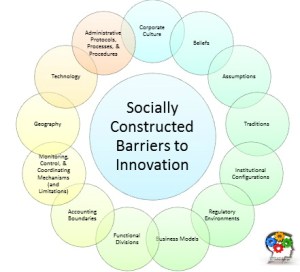Socially Constructed Barriers to Innovation (SCBI) represent some of the most prolific, and yet theoretically resolvable, obstacles to corporate creativity. They represent the most prolific because they are so common and are yet simultaneously the most theoretically resolvable because their absence can be easily imagined. Reality reconciles this paradox in the realization of how fixed and often impermeable these constructs are.
Wikipedia defines Social Constructionism as follows:
“Social constructionism or the social construction of reality (also social concept) is a theory of knowledge in sociology and communication theory that examines the development of jointly constructed understandings of the world that form the basis for shared assumptions about reality.”
Social Constructivism is useful as a model because it helps corporations and teams to reevaluate existing practices in the pursuit of opportunities that will better serve stakeholders. The configuration of institutions, strategies, policy, benchmarks, and thus expectations are heavily influenced by social constructions that vary by corporate geography, industry, and mission.

Like the metaphorical elephant in the room, socially constructed barriers to innovation (SCBI) are resistant to corporate supported analysis, deconstruction, and replacement because they are often reinforced by the existing norms.
This list of reinforcing mechanisms (list) is not exhaustive. The route to reconcile othe limits these reinforcing mechanisms place on corporate innovation is determined by the role and purpose of each. Does the mechanism:
- Seek to maintain a ‘competitive advantage?
- Retain place in/share of the market?
- Secure self-sufficiency?
- Decrease the perception of risk?
- Maintain ‘current profit margins?’
- Deflect unwanted interventions or takeovers?
- Maintain the status quo?
This list of why innovation (and change) is resisted is not exhaustive but helps to highlight why change, and the competencies and processes that support innovation (SCBI) are often resisted. Untangling the justification for innovation among competing rationales requires more than just investment in ‘doing things better.’ It requires:
- Insight into the mechanisms that reinforce resistance to change
- Insight into the levers available to promote change and innovations
- The authority & skills to negotiate the corporate environment (of competing priorities and values)
- The buy-in and support of executive leadership
- The support and authority to change processes, clarify priorities, and allocate resources
This list of competencies needed to introduce change and support innovation is not exhaustive. The complex resources, supports, knowledge, skills, and abilities needed to overcome the often hidden barriers faced when introducing something new is often unavailable in the beginning. It needs to be secured through networking, relationship and capacity building efforts, training and coaching, and identification of the corporate pain points.
- Drop in revenue
- Difficulty retaining talent
- Error rates
- Drop in quality
- Drop in productivity
- Change in leadership
- Regulatory changes
- Loss of corporate knowledge
- Competition
- Poor technology to problem fit
- Training
Once the corporate pain points are identified the purpose for introduction the change, and thus solution to the pain point, is more easily recognized. Support for the change then flows more easily.
How is your company identifying its customer pain points? Corporate pain points? And solving them? Share your comments below.